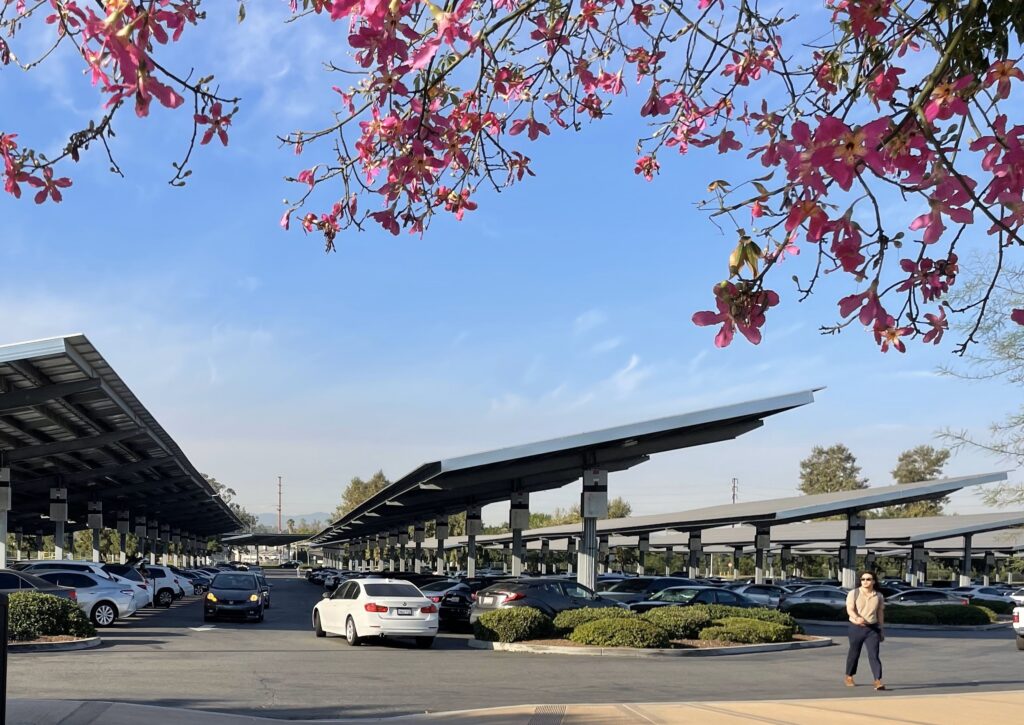
The UC Riverside parking lot is filled with the cars of students who commute.
Credit: Omisha Sangani
As we head into a second year of delays and confusion around FAFSA, the Free Application for Federal Student Aid, it is more important than ever to revisit the daunting financial scene many college students face today.
Beyond tuition, students incur additional costs, including on-campus housing, meal plans and indirect costs not paid directly to their college/university. Indirect costs include, among other things, books, transportation, off-campus housing and a computer. For California students living off campus, indirect costs are roughly $21,000 a year (and are even higher for students who live on their own).
With an eye toward costs, many students opt to commute rather than stay on campus because it is cheaper, they can live with family (which may include caretaking for their parents, siblings, and/or children), or they have other responsibilities at home to maintain. For example, 60% of UC students, 86% of CSU students, and 85% of all college students across the U.S. commute to campus.
The 3E Study is currently collecting economic, educational and health and well-being data from students at public California State University (CSU) and University of California (UC) campuses over time. We asked participants about how things were going this past school year and their most satisfying and disappointing experiences at their institution.
One trend immediately emerged from the results: Attending their schools is expensive, and commuter students are struggling.
Many students in our study described having to drive over an hour each way to get to school every day. The challenges posed by their commute often prevent students from thriving, both academically and socially, during a critical time in their development.
The participant responses bring to life the grim picture:
“I expect to be exhausted as classes end every day. My commute has taken a greater toll (avg. 100 minutes one-way) on my time management than I anticipated, and this is the greatest factor preventing me from being more involved on campus,” one student says.
Other commuting students shared that “it’s a lot harder to make friends” and “I work part-time and commute three hours a day for school.”
Commuting is an issue of affordability that is exacerbating unequal education access. When low- and middle-income students do not have affordable housing options on or near campus, are facing too many other expenses even to consider on-campus housing, and/or are juggling other responsibilities like caregiving, they may have limited options for where to live, regardless of how far they are from campus.
Living at home and commuting to and from campus also introduces new financial stressors. Many commuter students struggle to pay for gas. While living at home may be more affordable than staying on campus, financing a new tank of gas every few days is no bargain.
One participant who commutes from Los Angeles to Riverside (roughly 55 miles) for school writes, “A limitation that I keep having is the lack of money … gas is basically now an absolute necessity for me to even consider earning a higher education.”
Expanding affordable options and resources for students is the key to minimizing these class-based inhibitors to college access. For example, some institutions are creating specialized orientation programs and resources, such as commuter centers (areas with dedicated commuter-specific facilities such as a fridge or computers), to help these students feel more connected and supported during their college experience.
To decrease the financial burden of commuting, colleges should partner with local transit agencies to offer free public transportation to all students (a program that many California colleges are already implementing). When determining financial aid allocations, schools should consider the cost of commuting as part of the cost of attendance for any students not living on campus. Creating special grant programs designed to reduce tuition costs for commuter students allows students to put tuition savings toward affording gas and/or car payments.
Commuter students statewide are facing high tuition and high indirect costs. Better supporting the costs of commuting will help ensure an equal chance for everyone to get an accessible college experience.
•••
Isabella Yalif is an undergraduate student in economics and sociology at Vanderbilt University.
Lindsay Hoyt is an associate professor of applied developmental psychology at Fordham University and co-leads the 3E study.
Alison Cohen is an assistant professor of epidemiology and biostatistics at the University of California San Francisco and co-leads the 3E study.
The opinions expressed in this commentary represent those of the authors. EdSource welcomes commentaries representing diverse points of view. If you would like to submit a commentary, please review our guidelines and contact us.

